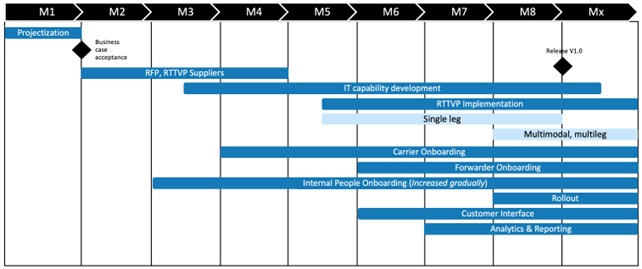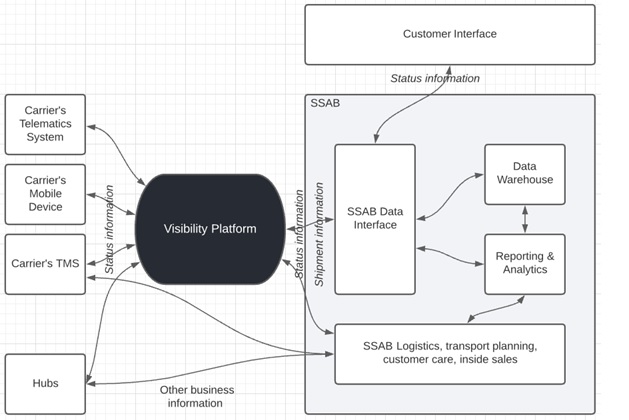Blog and video: Next-level customer service with real-time transportation visibility
Why the project was successful and what were the key takeaways?
1. Reaching end-to-end shipment visibility
We have now rolled out the new platform, but this is a progressive journey. The project goal was to create harmonized visibility for product shipments. The business case was based on improving customer service and meeting customer expectations. Customers want to know where their material is and when it will be available for use. SSAB wanted to know more about what happens during transportation and to avoid slow, tedious and incoherent manual tracking activities.
In the past, the customer typically asked sales, who asked customer care, who asked transport planning, who in turn asked the carrier before the information flowed back. Besides being a slow process, it is also very error prone. With TnT, the customer can see shipment status directly on SSAB’s customer user interface or can ask sales, who can then find the information directly on the visibility platform.
Besides improved customer service, SSAB is also able to gain a comprehensive view of what happens in transportation. That is very helpful in developing the transport process and in being proactive before events occur in the logistics chain.
Conceptually, the project was to collect transportation load information from source systems, create harmonized load data, provide the required data to be visible on the vendor’s platform, receive tracking information back from the visibility platform and provide it to the customer interface and internal data warehouse. Besides the technical part, it was noted early on in the project that carrier onboarding to provide the location updates for the visibility vendor is a very critical part of the work.
The project started with preparation work on what to do and how to do it. The work started in the beginning of 2021. SSAB realized that external resources were needed to complement capabilities for effective project operation and architectural setup.
Figure 1. Overall system architecture including IT capabilities, RTTVP and Carrier systems.
2. Running a Track and Trace project requires a comprehensive effort from logistics and IT
Implementing TnT in a company requires the establishment of a solid platform and technical capabilities to handle load data. There are, at least, four development areas to be considered.
a. Internal IT work – Creating transportation loads and transferring them to a visibility platform
b. Integrate to a visibility platform – Enable global load tracking
c. Onboarding – Integrate carriers into a visibility platform
d. Reporting and Analytics – Making data insightful for customers and internal users
The first step was projectization. The project resources were selected, agile scrum methodology was used in internal solution development and a schedule was set along with other typical activities that need to take place in the project initiation phase.
One of the most important activities was to select a visibility vendor. Comprehensive competitive tendering took place in spring 2021. All of the largest visibility platform providers and some smaller vendors participated in the bidding. It took just 12 weeks before SSAB signed the contract with the winner.
Internal IT development got under way a bit earlier to make data available for the visibility platform. The challenge was to harmonize load data from various source systems. It was therefore practical to start developing an SSAB data interface, which required data storage for all the company’s loads regardless of the mode of transport. This meant that loads for trucks, sea and rail were normalized into a single data entity that collected all the data pipelines from the mills. This activity was the biggest internal consumer of resources in the development phase.
The most time-consuming phase of the project, onboarding, then took place. Leadership between project managers was divided into two branches. One project manager, as the internal logistics professional, was responsible for working with internal sales, logistics and the visibility vendor to facilitate successful onboarding with carriers. Technical project lead’s work was to lead the IT activities and enable dataflow from the source systems to the visibility platform and back to the internal analytics platform and customer interface.

Figure 2: Project schedule.
3. Retrospective of the project – Key success factors and takeaways
In the project, SSAB implemented the TnT platform that can handle truck, rail, and ship transportation. SSAB now has shipment visibility, which it can offer both to external and internal users. However, what were the key success factors and takeaways?
#1 Establishing basis for success
Great management support is essential for success. Fortunately, SSAB’s TnT project was given high priority before it even started. However, several other success factors can be identified that helped to make the project successful:
• Importance of the vision: The underlying justification to initiate the project was clear customer demand – making truck, rail, and sea transportation visible to all relevant user groups inside and outside the company originating from all the mills. Since there was a clear vision, it was easy to gain buy-in from the different groups.
• Structured work and collaboration: The use of modern principles, methods and technologies in developing the solution made progress transparent, measurable and easy to lead. The multivendor network used the same tools in communication, development and design.
Weekly DevOps meetings kept everybody on board and things moving. The project owner and technical lead had a daily morning meeting to answer any questions and to focus on the next steps. The external consultant had experience in the use of the DevOps method, which also helped to expedite the technical work. Clear specifications from the visibility vendor facilitated the work while the integration work took place.
• Excellent resources: One of the key success factors during the project was the outstanding project team. Project management during project initiation identified the necessary resources needed and what was available to the project.
The development team was experienced and capable. Fortunately, SSAB had excellent internal resources for IT development (architecture, integration, source system specialists, platform support and customer support) and conducting carrier onboarding. They knew the existing systems and were willing to participate.
The external help (technical lead/ architect and external developers) was very skilled and willing to cooperate. There was also excellent team chemistry.
Furthermore, the visibility vendor’s technical specialists provided clear input. They were also very capable and helpful. All participants in the project had a clear role and worked in the same direction. Stakeholders supported the project and had confidence in the project team. This allowed for efficient decision-making.
#2 Internal IT capability development
The project team noted a few considerations to be aware of when implementing a company-wide information system change to offer transport data for external parties, as in this TnT project.
• Harmonization of data, integration, and information flows: SSAB has four main mills with different source systems due to various mergers during company’s history. This made it important to initiate data harmonization activities and to start utilizing an integration platform at the start of the project. This in turn made it relatively easy to normalize data and make loads for the visibility vendor.
• Single source of truth: The decision to establish a service layer with a large amount of data storage between the company’s IT systems and the external visibility platform was one of the best decisions in the project. Collecting all load data from multiple internal sources into one single data storage created two important advantages. It allowed for easy communication with the visibility platform and, at the same time, internal reporting and analytics. Enriching data internally also became important. It was much easier to implement while the TnT’s single source of truth was available, and the corporate common data warehouse just waited to be integrated.
#3 Visibility platform capabilities and maturity level
The project took place in 2021. The visibility platform landscape was very broad. However, the maturity level of the visibility platforms had reached the appropriate level. Still, the capabilities of the platforms didn’t approach the 100% required in this TnT project.
What was evident was that utilizing visibility platforms was the right way to implement the visibility of transportation. Compared to make-your-own-visibility-platforms, there are many out-of-the-box features available in the biggest visibility platforms. In this case, the discussion to build a separate visibility platform was short – the implementation project would have taken too much time, effort and money.
• Multi-leg and multimodal transportation is a challenge: All visibility vendors can provide TnT for single leg transportation for various modes. Challenges arise when material is moved from one transportation vehicle to another many times during the journey. If the shipper is not the party ordering the final transportation leg in a multi-leg case, it is not known when the material is at its final destination. Nevertheless, visibility vendors can integrate with the forwarder’s IT systems to make multi–leg and multimodal visibility possible. These integrations must be implemented to calculate the ETA, and this is time consuming.
• Reporting and analytics capabilities are not yet ready: There are reporting capabilities available on some visibility platforms. However, these are not as comprehensive as would be expected. Basic reporting can be conducted. However, it is strongly recommended to initiate reporting and analytics development internally during the implementation project. This ensures that all data is owned by your company and data is available for internal use without limits.
• Get invited to the visibility vendor’s R&D board: As already mentioned, the world of visibility platforms has evolved quickly, and new functionality is implemented every week and month. However, it is very beneficial to take part in the vendor’s development community or even better, get invited to the visibility vendor’s R&D board to push and prioritize initiatives that are highest on your backlog. Would you rather be an influencer or passenger?
#4 Onboarding
Onboarding is the most time-consuming activity in the whole TnT implementation project.
• Carrier capabilities to provide data: There are various levels of capabilities on the carrier side to provide load data electronically. Some integration implementations might take only a few days, while some system integrations takes months.
• No standards! Implementing and integrating tens or hundreds of carriers into one system is a time-consuming task. This must be done without a common standard. It is not stated how integrations should be undertaken or in what format data should flow from telematics or TMS systems. Fortunately, a set of technologies are available. EDIs, Excel CSVs or even APIs can be used.
• Communication challenges between multiple parties during technical onboarding: Solving technical issues in a multi-party environment with a clear understanding is the key to success. The visibility vendor is responsible for integrating the carriers. Nevertheless, when the carrier becomes unresponsive, it is up to the shipper to solve the situation. This dance takes all three parties.
4. SSAB is an international forerunner in transportation Track and Trace
Very few companies have implemented TnT globally.
Tens of onboarded SSAB’s carriers now take care of millions of tonnes of shipments worldwide. There are continuously thousands of loads in transit that can be transparently traced via a visibility platform.
Harmonized load data is sent to the visibility platform and used for data storing and internal analysis. Combined with the tracking data, SSAB can now analyze what happens during transit and can work more proactively on delays. In addition to logistics improvements, SSAB can collect emissions-related information about shipments, since the company has made improving sustainability a top priority.
Nevertheless, the show must go on. Onboarding never ends. Although one carrier might be integrated, another company’s contract can end. Onboarding activities continue every month and every year. Reporting and analytics also have a learning curve. There are almost infinite possibilities of turning data into insight. Therefore, data mining becomes more interesting every day!
Customers now have access to instant information about their shipments. Compared to the previous situation, everyone involved in the transportation process has the opportunity to follow shipments conveniently without middlepersons – 24/7. Customers demanded transparency on transportation. Here it is!
